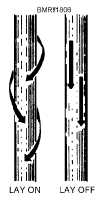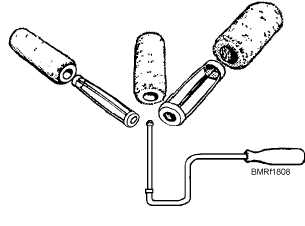Large areas, such as ships’ decks and sides (free of
rivets, bolts, cable, pipes, and so on), can be covered
with paint quickly by the roller method. The paint
should be laid on and laid off the same way as when
brushes are used. Apply a moderate amount of pressure
to the roller to make sure the paint is worked into the
surface. If pressure is not applied, the paint doesn’t stick
and soon peels off. When the paint roller is properly
used, it will apply a more even coat and use less paint
than with a brush.
CARE OF BRUSHES AND ROLLERS
Unfortunately, too many good paintbrushes and
rollers are ruined because painters have little or no idea
how to care for them, or they are too lazy to clean them.
To avoid ruining paintbrushes and rollers, pay attention
to the following hints. Treat applicators as though you
paid for them yourself, and replace them when they no
longer are usable.
Do not let a brush stand on its bristles in a pot
of paint for more than a few minutes. The
weight of the brush bends the bristles, making it
almost impossible to do a good job.
Never allow paint to dry on a brush. If you
intend to leave a paint-filled brush for long
periods, as over the noon hour, fold wax paper or
other heavy paper around the bristles and ferrule
in such a way that air is kept away from the
bristles. Twist the paper around the handle and
secure it with rope yarn or sail twine. Cover your
pot of paint, and place both it and the brush in a
safe place. Before starting to paint again, stir the
paint thoroughly with a paddle—not the brush.
At the end of the day, clean as much paint
from the brush as possible by wiping it across
the edge of the paint pot or mixing paddle.
Then turn in your paint and brush to the paint
locker.
Ordinarily, the person or persons working in the
paint locker will clean and stow the brushes turned in.
Occasionally, though, they require help; and you may be
detailed to the job. If so, follow instructions carefully;
and do a thorough job of cleaning the brushes.
18-19
Student Notes:
Figure 18-7.—Cutting in.
Figure 18-6.—Painting pipes and stanchions.
Figure 18-8.—Parts of a paint roller.






